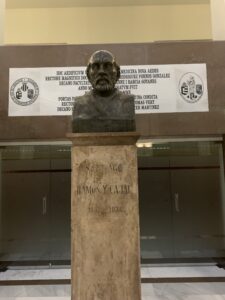I see the future with great hope. I believe that Digital Pathology is a hidden treasure that we don´t know for sure what is capable of. I want part of it.
During this time, I have carried out academic activities directed and personalized by my director Dr. Carlos Monteagudo, which consists of the review of histological sheets of dermatopathology from the Hospital Clínico de Valencia, in order to be trained in the proper interpretation of all inflammatory and morphological cutaneous patterns with a special emphasis on melanocytic lesions. This training is essential for me to be able to analyze the specific characteristics of Spitz tumors and to have the ability to look at their differential diagnoses that have a high difficulty due to the fact that these characteristics overlap in other tumor entities.
I was in the Dermpedia Online CME Course: Spitzoid Melanocytic Tumors: Histological-Genetic Correlations: Expert Analysis of 70 Spitzoid Melanocytic Proliferations With Known Genetic Changes which was held from May 26-28th.
I have made a database of Spitz tumors that have been collected over the last 30 years in the Pathological Anatomy laboratory of the Hospital Clínico de Valencia, reaching a collection of 200 cases, where 50% are benign tumors and the other 50 % are malignant and of uncertain malignant potential. In addition, it performed the scanning by means of WSI (Whole Slide Imaging) technology of 74 histological slides of Spitz tumors in order to be analyzed for their respective segmentation and extraction of morphological characteristics under Convolutional Neural Networks (CNN).
I am currently working in conjunction with the National Cancer Institute of Colombia and Keralty (who has the largest pathology laboratory in Colombia) so that these large Colombian institutions participate with their bank of cases of spitzoid tumors.
Due to the current situation due to COVID-19 I had to virtual secondments in Roche Diagnostics attending live conferences and other asynchronous ones about pathology issues, and in Erasmus Medical Center (EMC), Rotterdam (The Netherlands) participating in bladder pathology courses analyzing WSI images of urothelial carcinomas and reviewing them with the EMC uropathologist once a week. In addition, I participate in the research meetings of the Urology and Molecular Pathology group of the institution, listening to the progress of the studies that are being carried out with an important molecular and technological approach.
I participated in the 1st CLARIFY training school & Review meeting and I made a presentation about my project and a conference addressed to the other ESR called “Histopathological basics for non-Physicians”.
Regarding publications and conferences:
An article in which I am a co-author called “An attention-based weakly supervised framework for spitzoid Melanocytic Lesion Diagnosis in WSI” was accepted at the Artificial Intelligence In Medicine (AIIM) journal and is pending to be published.
Together with Laëtitia Launet, we wrote a chapter called Artificial Intelligence in Digital Pathology, part of the book APPLIED MOLECULAR ONCOLOGICAL PATHOLOGY for the Health Sciences University Foundation which will be published in 2022.
I did an online conference for the Colombian Association of Pathology – ASOCOLPAT called “Artificial Intelligence for Pathologists” which is published on YouTube with more than 400 views.
This period has been very profitable since the learning obtained has been fundamental for the development of my thesis. The direction given by my Director has been very enriching due to his great contributions and interest in carrying out the thesis.
I see the future with great hope. I believe that Digital Pathology is a hidden treasure that we don´t know for sure what is capable of. I want part of it.

Dr. Santiago Ramon y Cajal sculpture bust. Faculty of Medicine Universitat de València.
Andrés Mosquera-Zamudio – ESR12

